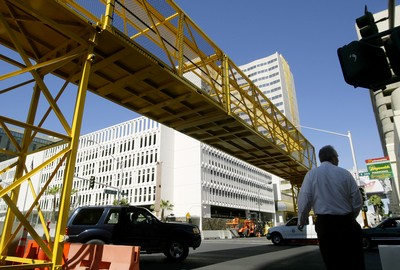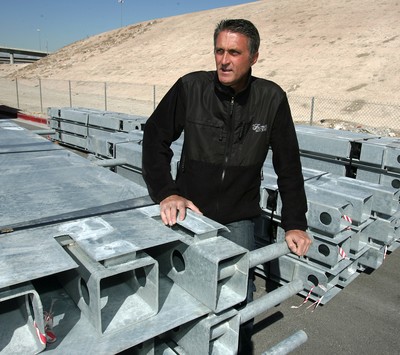Race’s start is Kneifel’s finish
Chris Kneifel is near the last turn of a race that began four years ago.
When practice begins Friday for the inaugural Vegas Grand Prix, open-wheel speedsters will take a green flag and christen the 2.44-mile circuit on downtown city streets. But a simultaneous checkered should wave for Kneifel as his construction for the race will be complete.
He will have lapped the circuit more than any racer, though most of his were taken in a pickup truck going 20 mph. Instead of wearing a helmet, he occasionally had to don a hard hat as circuit manager of the do wntown race.
Kneifel, 45, had the responsibility of converting city streets into a racing circuit. And he only had about three months to do it while not greatly impeding normal traffic flow.
"It's more fun than racing," said the former driver, who competed in the Champ Car World Series when it ran under the CART banner. "There's the satisfaction of doing something that's never been done before."
Kneifel, a native of Chicago living near Phoenix, was a successful racer for around 20 years. He finished eighth in the 1984 Caesars Grand Prix, held in a parking lot at Caesars Palace.
He started 19 CART races from 198284 and finished in the top 10 six times.
He also was part of the trio that won the prestigious 24 Hours of Daytona in 2001.
"I got rid of the needle," he says of an addition to racing that began the day he turned 18.
After leaving the cockpit in 2001, he joined CART as its chief steward (race director), a position he held until 2004.
During those tumultuous days, CART's luster of the previous several decades began to tarnish, with loyalty in the country's oldest form of racing split by the formation of the rival Indy Racing League in 1996.
The divided world of Indy-style racing also took a back seat to the burgeoning NASCAR juggernaut.
Kneifel's world is filled with memories of great left- and right-hand turns, which has led to a unique knack for converting city streets into challenging and entertaining racing circuits.
"After winning a race, there's a great sense of self satisfaction you feel. It's a cliche, but it hits you later. It's usually exuberance in a private moment.
"Building a good circuit like this is similar. The difference is that one comes in an acutely competitive environment.
"I'm not living in the competitive (racing) world I did for 20 years. Money didn't get me out of bed this morning."
Kneifel meant that figuratively. While touring the course with a reporter one night a couple of weeks ago, he said he had not slept for about 65 hours, and a bed wasn't in the forecast for the next 24.
Fans will cheer a driver for a good pass or a victory. While building this street course, often the only spectators were vagrants, one of whom threatened an equipment operator that unless given $20, he'd claim he was run over by the forklift.
So it goes when building an urban street circuit.
Kneifel could fill a book with stories and challenges since he began work on the course.
The project started somewhat shrouded in secrecy in 2003, when CART sent him to town to begin a clandestine feasibility study of potential locations to stage a race.
After the Las Vegas City Council voted unanimously last July to allow the race, Kneifel began spending three or four days a week in town. He has not left Las Vegas since early January.
He's designed courses and erected others over the past three years. This year, he is planning the new circuit near downtown Phoenix, which, like the Vegas Grand Prix, is an event owned by Dale Jensen and Bradley Yonover. He also will set up the course in San Jose, Calif.
"It takes proper planning and due diligence," Kneifel said. "If everybody rows together, you'll get somewhere. It's coming together.
"For (people downtown) to see something they've never seen before ... for them to say ‘wow' and understand what we started talking about in September and October, is rewarding.
"We could tell all of them the story about what we planned to do, but only we could see what's in our minds.
"It's fun to see the excitement grow."
He considers city streets a challenging pallet.
"We have to go to our wits sometime. That's where the artistic part of designing a course comes in."
Two of the most unique aspects of the course are the entrance to pit road and the first turn after leaving it.
Drivers will complete a lap after heading west on Ogden Avenue from Third Street. As they cross Main Street, the elevation drops heading into the railroad underpass. There will be ample time to either stay right to pit or stay left of the divider and continue downhill through a curve to a sweeping left-hander onto Grand Central Parkway.
"We put the pit split in for safety," he said. "This is where having a driving background comes into play.
"Most race track promoters are looking at dollars and cents. I wouldn't want to be the guy coming up the hill and having a surprise (dead car)."
Cars leaving pit road will have less than a quarter-mile to get back to speed before making a sharp left onto Bonneville, which Kneifel said will be the fastest part of the course, with cars approaching 190 mph.
"I tried to build in something missing from North American racing; a course that's fast and forces drivers to bring their ‘A' game.
"The width of the racing surface is massive for a temporary or permanent racing circuit. By and large, it's a very smooth circuit.
"It will be spectacular."
But he doesn't expect rave reviews from the racers, even if they like it.
"It's unusual if they heap praise; it's not their nature or their job."
He's only worried about doing his.
"I've always only wanted what's the best for drivers and best for creating competitive races."
Vegas Grand Prix
























